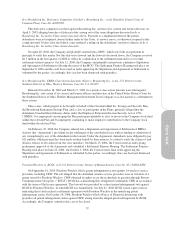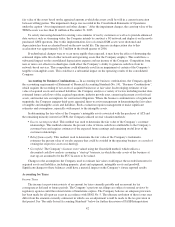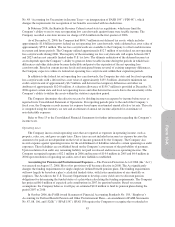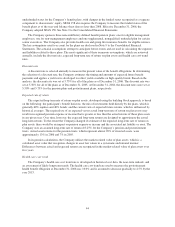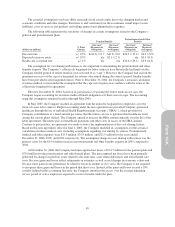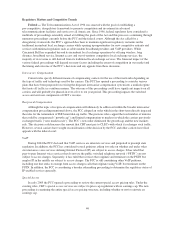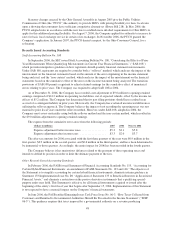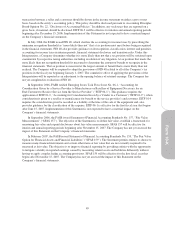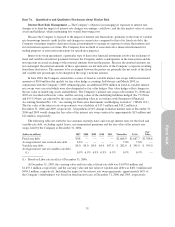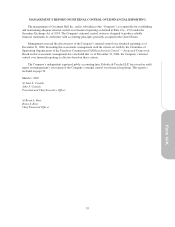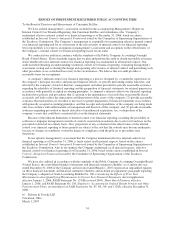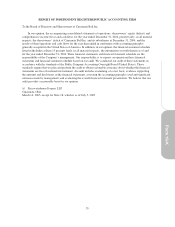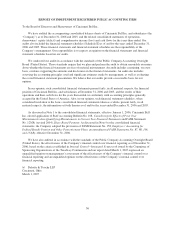Cincinnati Bell 2006 Annual Report Download - page 157
Download and view the complete annual report
Please find page 157 of the 2006 Cincinnati Bell annual report below. You can navigate through the pages in the report by either clicking on the pages listed below, or by using the keyword search tool below to find specific information within the annual report.
Universal Service
The federal Universal Service Fund is currently funded via an assessment on all telecommunications
carriers’ interstate end-user revenue. The FCC is currently considering alternatives to this method of funding.
Some of the alternatives being considered include expanding the base to include intrastate revenue or switching
to an assessment based on connections and telephone numbers. Any such alteration could result in a change in
the manner in which carriers recover their contributions from end users.
Unbundled Network Elements
In early 2005, the FCC rewrote its unbundled network element rules in response to the federal court’s
remand of the previous rules. The latest rules have no significant impact on CBT. However, the elimination of
unbundled circuit switching, and thus the UNE platform (“UNE-P”), required CBET to migrate its UNE-P lines
to alternative arrangements by March 11, 2006 and/or to negotiate with the underlying ILEC for continued
provision of UNE-P, which CBET did pursuant to a commercial agreement. This is not expected to have a
significant adverse impact on CBET since CBET had already planned to migrate the majority of its customers to
its own switching facilities.
Broadband Internet Access
In an order adopted in the third quarter of 2005, the FCC provided wireline carriers the option of offering
broadband Internet access as a non-regulated information service (comparable treatment to cable modem Internet
access) or as a regulated telecommunications service. Each option has associated costs and benefits that must be
weighed in light of a carrier’s current mix of existing services and new services the carrier may be contemplating
offering in the future.
FCC Inquiry Regarding Safeguards to Protect Customer Proprietary Network Information (“CPNI”)
By letter dated March 10, 2006, the Enforcement Bureau of the FCC directed the Company to provide
information and documents necessary for the Bureau to determine whether the Company has implemented
adequate safeguards and/or taken appropriate security measures pursuant to section 222 of the Communications
Act of 1934, as amended, to protect customer proprietary network information (“CPNI”). The Company timely
submitted its response. On October 25, 2006, the FCC issued a follow up letter asking for additional information.
The Company responded to the FCC’s subsequent letter on November 21, 2006.
State — Because CBT generates the majority of its revenue from the operation of its public switched
telephone network, its financial results follow no particular seasonal pattern. CBT does derive a significant
portion of its revenue from pricing plans that are subject to regulatory overview and approval. In both Ohio and
Kentucky, CBT operates under alternative regulation plans in which CBT cannot increase the price of basic local
services and is subject to restrictions on its ability to increase the price of other related services. In return, CBT is
not subject to an earnings cap or recapture in Ohio, as it would if regulated under a traditional regulatory plan
based upon a targeted rate of return. CBT has operated under alternative regulation plans since 1994 during
which price increases and enhanced flexibility for a limited number of services have partially offset the effect of
fixed pricing for basic local service and reduced pricing for other, primarily wholesale services.
In June 2004, CBT adopted a new alternative regulation plan in Ohio, which, although similar to its
previous plan, gives CBT the option to remain in the alternative regulation plan indefinitely. Also, CBT’s new
plan requires the Local segment to operate as a CLEC in service areas outside of CBT’s traditional ILEC
franchise area. For approximately the past six years, CBT has offered local services, primarily on its own
facilities-based network, to Ohio communities contiguous to its ILEC territory. In Dayton, the Local segment has
provided its voice services offering using the port-loop-transport combination (UNE-P) as well as the UNE-L
regulatory format. On February 4, 2005, the FCC released its unbundled network elements order on remand
which will effectively abolish UNE-P as a regulated service and has left each carrier to negotiate new pricing
arrangements under commercial agreements. The Local segment has entered into such an agreement; however, it
does not expect the profitability of its Dayton local operations to change substantially because the segment had
planned to migrate the provisioning of service to UNE-L, which is a more economic service delivery model as
the segment has gained customers.
47


